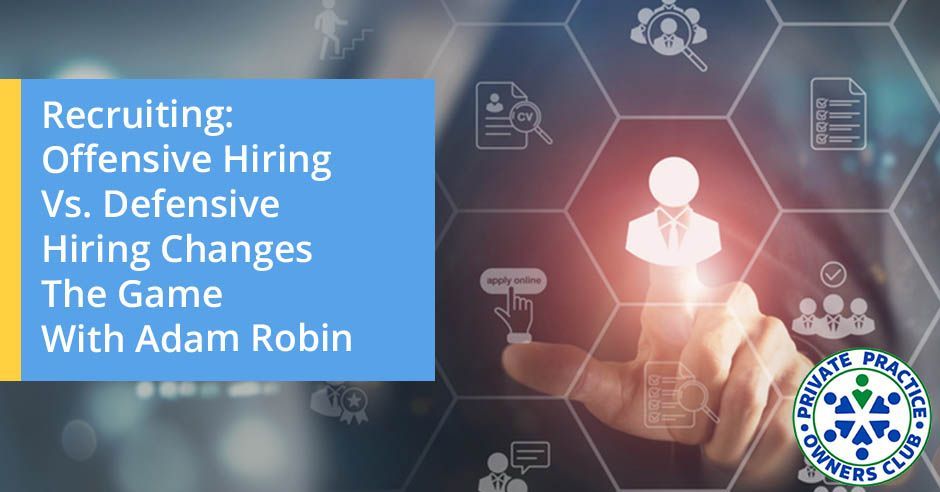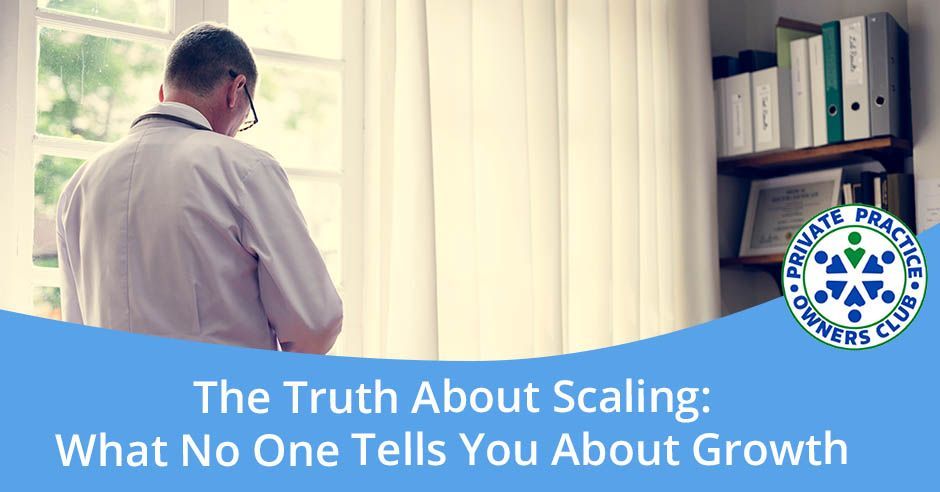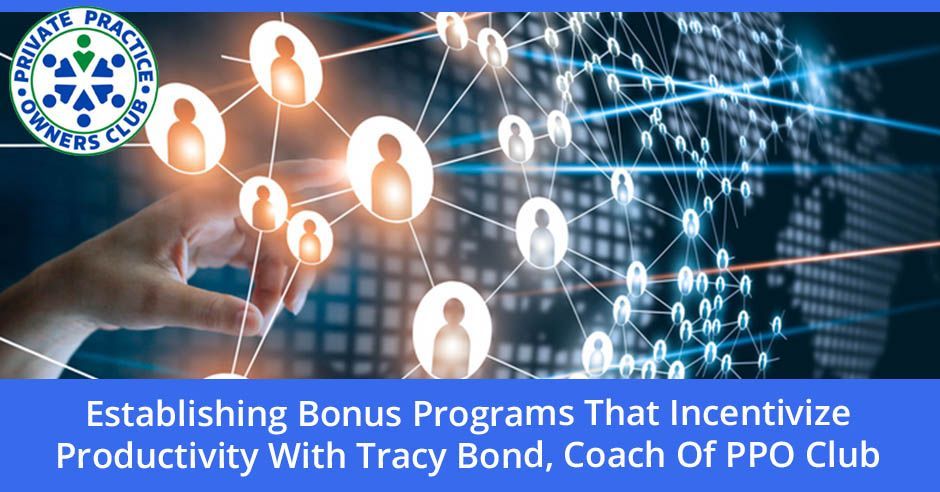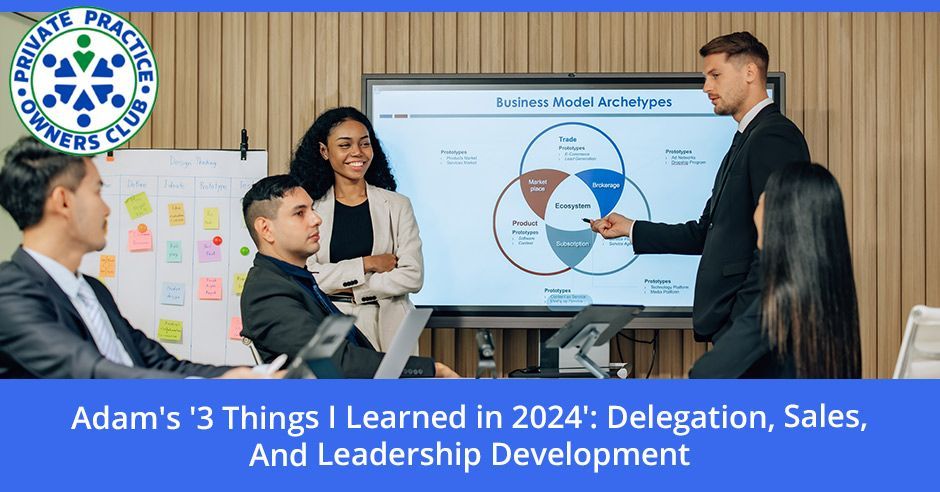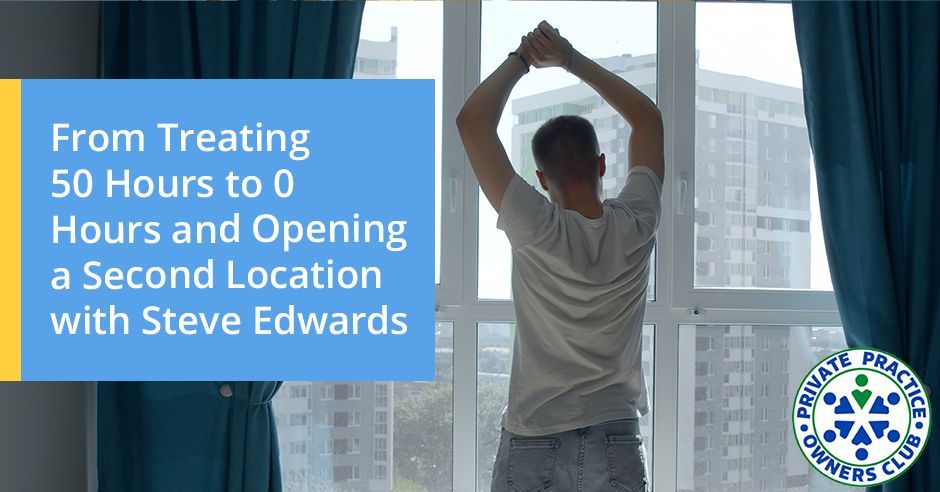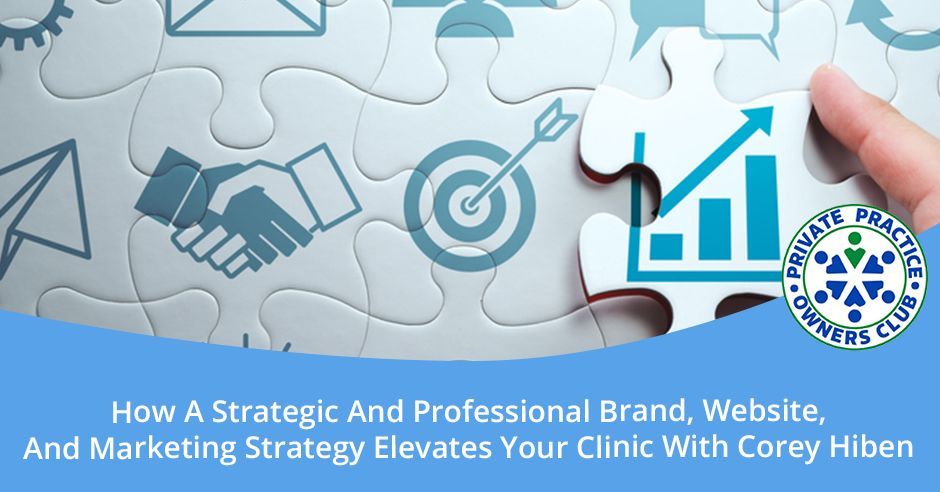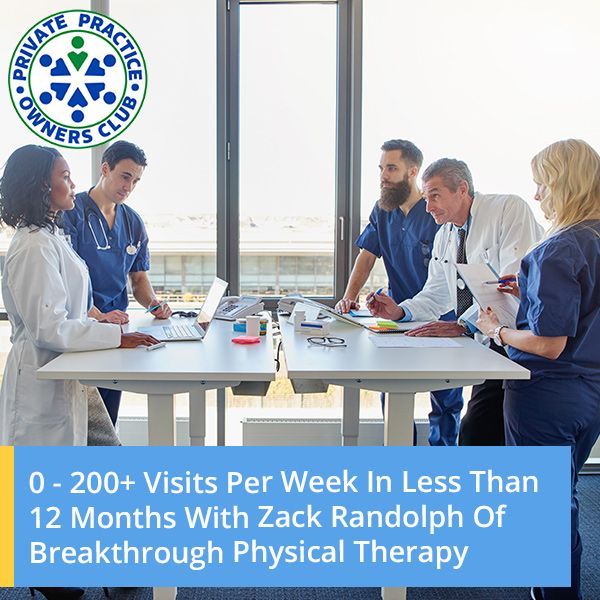The 5 Buckets Of Recruiting - Practice Owners Manual Series Part 8

Uncover the secrets to defining your ideal hire and using this profile to guide your recruitment strategy. Plus, learn how to leverage platforms like LinkedIn and Facebook to connect with potential hires and build relationships before you even post a job ad. You'll also explore how career fairs, internships, and guest lectures can be your secret weapons for recruiting fresh talent. And that's not all – discover how to tap into your existing contacts and local community to find hidden gems that might be the perfect fit for your clinic.
Listen as Nathan taps into Adam’s expertise in recruiting PT, OT, and speech therapists. Get ready to learn the steps to attract the best candidates who align with your practice’s values and vision.
Don't miss " The 5 Buckets of Recruiting - Practice Owners Manual Series Part 8" – it's packed with valuable insights for private practice owners!
Want to talk about how we can help you with your private practice, or have a question you want to ask? Book a call with Adam -
https://calendly.com/adamrobin/dr-adam-s-30-minute-connection
Love the show? Subscribe, rate, review, and share!
https://ppoclub.com
--
Listen to the podcast here
The 5 Buckets Of Recruiting - Practice Owners Manual Series Part 8
Welcome to the show. We are into it with episode number nine of our Private Practice Manual Series. We’ve had eight thus far. We’re in number nine. We’ve talked about a ton of topics as it pertains to establishing a well-rounded and well-established private practice. I highly recommend you go to those previous episodes. We’ve done plenty of them, so check them out. Back with me is Adam Robin. Thanks for joining me.
Thanks for having me here. I’m grateful to be here.
We’re talking about something that you’re an expert in, and that is recruiting.
I don’t know about that.
You’re an expert in recruiting. If there are two experts I know in my life about recruiting for physical therapists specifically, and you recruit for OTs and speech as well, it’s you and Will Humphreys. You guys have it dialed in. You know how to do it. You’ve hired how many people in the past couple of months of 2024?
Thirteen.
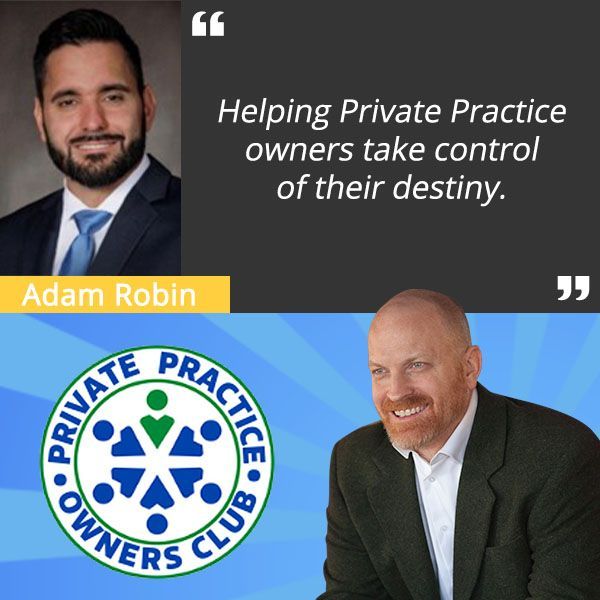
You’ve hired thirteen providers, which, to me, is unheard of. I’ve heard nothing like that from other providers that I’ve talked to and worked with. You know how to do it. We purposefully did not include this in episodes 1 and 2 of part 7 related to practice management, the general structures, and the employee experience. We left this as a beast unto itself and deserves a full episode because there’s a lot of difficulty when it comes to recruiting providers. I’m sure it’s across the board, not just in PT, but OT, speech, and mental health. You name it.
There’s plenty of work that goes into recruiting. It’s something that as owners, we’re not necessarily used to. We think that the one and only way to do it typically is TO post an ad on Indeed or maybe have a student once a year or something like that. If you’re lucky, they join your team. There’s so much more to it. I’m glad that I have you to relay exactly all the things that you can do and should be doing if you’re desperate for a provider. This is something that you’ve spent a lot of time on, right?
Tons of time. It’s a whole another skill. It’s important to highlight that this section is towards the end of the manual because it really is its own beast. Having the mindset of how to set your practice up in a way that adds value to other providers is step one. You’re building out that organizational structure, the training, the job descriptions, and all that value. After you have that product all polished and it’s cool and nice, it’s like, “Let’s promote it. Let’s promote what we do, who we are, how we help people, and how we help providers.” You can input all that into the recruiting system and, ideally, find some people that can help you grow your company.
I would never say to hold off on hiring somebody simply because you don’t have all those other steps done beforehand. I would say if you were of a mindset to put the business first and had administrative time to work on some of those other things and get those established, you’re further along in making that a valuable win-win for you and this new provider that you wanted to bring on the team and their experience and their loyalty. Thus, the retention of them is in greater likelihood because you have the basics covered. You have the foundation set. You’re clear about your values, your purpose, and how you want things done. You’re clear as to the productivity numbers that you are expecting. You’ve had those conversations with them and they know what to expect. An employee handbook is in place.
All those things are nice. They’re not necessary. I hired plenty of providers that stuck with me for a long time without that stuff, but it makes the experience that much easier for you and enjoyable for you. It sets you apart as an employer when the provider sees you have those things before they come into your company. You don’t have to have it, but if you want to grow and scale, which will be our next episode, those things are pretty necessary. You have to have those pieces in place if you want to grow and scale successfully.
It gives you something to believe in. There’s the sense of pride that you, as the owner, can gain whenever you’ve seen something that you’ve worked so hard for and built that people are consuming on a regular basis and they’re having success. Once you feel that and you feel good about what you guys are doing, you can enter the job market or the recruiting market with a lot more boldness, confidence, and excitement. You can attract people that align with that, right?
Definitely. I believe that. When we’re talking about recruiting, when someone says, “I need a provider,” maybe their first intuition is to build out a job description for Indeed and then list all the qualifications of, “Make sure you have a license. Make sure you can type.” You list some of the basic stuff where you don’t even need to put those things in a job description. Where would you recommend people start?
Building Out Your Avatar
People need to start building out their avatars.
What is an avatar?
You should have an avatar. You should have an ideal characteristic or personality trait that you’re looking for. Who is this person that you want to hire? Maybe you even give them a name or a general demographic. What type of interests do they have? Where do they live? What type of patients do they like to treat? Why did they become a PT? Get inside the mindset of these people.
Here’s the thing. If you’ve done a lot of work on your purpose and values, you should be able to figure this out pretty easily. Being able to put some language and some words to who it is you’re trying to talk to is really helpful. You can sprinkle that type of messaging and speak to the person in your job ad, email campaigns, and social media outreach. Start with your ideal candidate and build out that profile. Where do they like to hang out? What are their interests? What are their hobbies? Are they married? Are they not married? Do they have kids? How long have they been a PT? What types of things excite them? That’s where I would start.

Will Humphreys noticed that if you are clear on that avatar, then another question you can ask is, what are their watering holes? Where are they going to live and see your message? It could be Indeed, but would they be more likely to be on Facebook or on Instagram? Would they be on TikTok versus LinkedIn? Where are you going to find these people?
Being clear on that avatar guides you a little bit as to where to put that ad or where to post that information, like, “This is the type of person that would ideally work with us,” but also, what do they want to hear? What are they looking for? If you know some of those things, if you know some of their hobbies, likes, dislikes, ages, and maybe even children if they have them, what do they want to hear in an ad that would make them interested?
It goes into the next topic. Let’s rewind. Let’s go back to the four buckets of marketing. Marketing and recruiting are so similar. With your marketing program, you’ve got your avatar. You’ve got your buckets of marketing. You’re trying to communicate with them the value of how you can help them, improve their quality of life, and improve their life in general and help them reach their goals.
Scratch out the word marketing and put the word recruiting. The buckets change a little but the strategy doesn’t. You’re communicating with that person and you’re trying to help them understand who you are and how you can help them reach their goals. It’s like, “I can communicate in a way that touches the things that are most valuable to you because I understand you. I’d love to have a conversation about potentially working together.” The marketing program and the recruiting program are very similar.
To use your phrasing, pull out your pad and paper and get your pen. At the top of your pad, you’re going to write the five buckets of marketing. Underneath that, the first thing’s going to be an avatar. You’re going to spend a few minutes, however long it takes, to get really specific as to the type of person that you want to see.
Put a name to them. Put a gender, age, family status, hobbies, likes, and interests, what kind of certifications you might like them to have, and what kind of personality traits you want them to have. List out your values and make sure that’s apparent in your ads and whatnot. These people would fall into those values and be aligned with them. After that, we can start listing 1 through 5 the 5 buckets of recruiting as we did with the 4 buckets of marketing.
That’s right.
#1: Job Ads
What’s number one?
Bucket number one is going to be everybody’s favorite. It’s the easiest one. It’s the most obvious one. Job ads.
We’re going to use them, right? We might as well.
Yeah. Why not? I don’t have statistics to back this up, but people go on Indeed or Monster.com. They go where the jobs are posted to look and see who’s hiring and what’s available. We want to be there. We want to make sure that we’re there. We want to not only make sure that we’re there, but also, we’re posting our ad in a way that communicates our purpose, communicates our value, and communicates to the avatar in which we’re trying to attract.
Writing out that job ad in a very unique way is really important. My one-liner is that the quality of your ad is going to be measured by the emotional response that you invoke inside the reader. You want to speak to their emotions. You want to speak to their pain points. You want to speak to their desires. When you can do that well, you can call forth, if you will, that person who aligns with who you are and who you’re trying to get to join your team.
The quality of your ad is going to be measured by the emotional response that you invoke inside the reader.
The default for most owners is to highlight what an amazing company that they have. They’re like, “I have this amazing company. You’d be lucky if you have these traits to be a part of it.” The wording that you’re implying is more about, “Are you a person that likes X, Y, and Z? Do you believe in these things? If this is what you’re looking for and you’re looking for this type of environment, these are the people that would thrive in our company. I’d love you to send in a resume.” Is that what you’re thinking when you’re writing an ad in those spaces?
Yeah. The point of the job ad is to get a resume. People buy with emotion. They justify it with logic. If you can create the emotional desire for them to apply, you could touch their curiosity in a way that says, “I don’t know much about the job yet, but I’d love to hear more about what they say.” That’s what you want to do with that job ad.
You don’t want to write the job ad in a way that’s like, “Here’s all the criteria of why we’re so cool.” What you really want to do is write the job ad in a way that’s like, “This is who we are. This is what we believe in. This is what we stand for. This is the mission that we have. This is what we’re super committed to. If any of those things sound of interest to you, we’d love to have a conversation with you. Click below to apply.”
Haven’t you shared examples of ads with people in the past? Would you be willing to share if people reached out to you?
Buckets Of Recruiting
Absolutely. A few people have reached out and requested a copy of the front desk or the patient care coordinator job ad. We have a few for PTs, OTs, and speech therapists. Reach out to me. Find me. Shoot me a DM and I’m happy to share that with you.
#2: Social Media
What’s bucket number two?
New Paragraph
Have you found any particular medium that does better than another in social media, whether it’s LinkedIn versus Facebook versus any others? There’s also Handshake.
I know that some people have had success on Reddit. I don’t use those. I’m not saying you can’t. I know that you can. I use LinkedIn and Facebook. That’s it. What I like about LinkedIn is that it has a great search feature. You can search and find candidates easily. The challenge that we have with LinkedIn is that the response rates tend to be a little lower. People don’t go on LinkedIn to chat. They’re typically there on a professional level. It’s maybe something they check once a month or so.
Facebook is a little more conversational. If I can find a physical therapist on LinkedIn or I could find you and I could connect with Nathan Shields where I’m like, “I want to connect with him,” I can go straight over to Facebook and put your exact name into Facebook. I can find you on Facebook, friend request you, and then I can maybe even start a conversation on Facebook. That’s how you can use those two platforms.
#3: Schools And Universities
What’s number three?
Third bucket?
Yes.
Schools and universities. Guess what they do every year? Graduate students. Guess what students are looking for?
Jobs.
If you’re not involved in the schools, you’re not recruiting. You’re missing a huge bucket. Here’s the thing. Those students want mentorship. They want to connect with people. They want to hear from you. They don’t know. They’re babies in this brand-new world and they’re looking for information. The faculty for these programs want support. They want people, outside vendors, and companies to come in and provide value to their students. They want to provide a positive experience to their class.
What a great opportunity to create a win-win, a win for you and the company, a win for your patients, a win for the students, and a win for the university. Go provide some value. Attend the career day events. Do the guest lectures. Accept the students. Provide internships. Set up those relationships. If you do that with a handful of schools, and maybe even cooler, if they all graduate their class at different times of the year where maybe these 2 over here graduate in the fall and these 2 over here graduate in the spring, you got a watering hole that feeds you students every year.
There’s a bonus element in there that Will came up with that I thought was ingenious. He provided practice interviews for soon-to-be graduating PT students. He would go to the career fair and offer to provide these practice interviews to give them insight into how they presented themselves and how they could better present themselves. It was almost like, “I’m giving you a little bit of something,” but at the same time, he was interviewing the students to see which ones stand out. He would be able to continue the conversations with those that really stood out. I thought that was an ingenious way that he was able to provide value but also filter out and use that as a recruiting tool as well.
The main things I like to do with schools are, number one, finding out when the career fairs are. They typically will do a career fair either virtually or in person every year for the graduating class. Sign up and attend it. Set up a booth and collect some resumes. Go every year. Number two, make sure that you have a student placement program built into your clinic, a productive one, where you’re accepting students every year. You’re evaluating therapists. Your providers are accepting at least one student a year, ideally, those who are from or willing to move to the area in which your clinic is and are interested in working in the setting in which your clinic is.
The third thing is to set up a guest lecture or provide mentorship opportunities, either personal development or professional development. We do lectures on marketing. We do lectures on sales. We do lectures on opening up clinics or private practices. You can do job interviews. You can do all kinds of fun stuff. If you set those three things up with your local universities, then you should be able to get your hands on a couple of students.
#4: Network
What do you have for number four?
Number four is going to be your network. If you’re like, “I don’t have a network,” you do. Go to your phone and download every single one of your contacts in your phone. Go to all your social media accounts and download every single social media connection that you have. Go to all your past emails and download all your emails. You probably have a list of people.
If you have those people, you want to make sure that A) They know that you’re hiring and that B) You’re communicating. You want them to know the types of people that you’re hiring and that you could really use their help in helping you find an amazing person who fits this type of criteria or this type of avatar. Setting up some email, text message, or phone call outreach to your network and your influencers is a big part of it.
Especially if you’re part of any youth recreation leagues or church membership. CrossFit members, your realtor, and your landscapers, these are the people that are like, “My brother-in-law is going to physical therapy school right now back in Tennessee,” or, “I’ve got so-and-so who they haven’t been a PT for a while, but they’re looking for a part-time gig.” That’s how you find some of these people. If they like them, more than likely, then they’ll refer them to you. Birds of a feather flock together, so they usually know who would fit with your personality. You want to leverage your network.
When you bring up a network, not only the people that we know, but we have access to other people’s networks. When I say that, I am talking about your state board having an entire list of all the licensees in your state. Depending on the state, you can gain access to not all of their contact information but at least maybe an email address. You can start emailing the licensees in your state about an opening in your clinic. That’s something that’s really simple.
The emails don’t necessarily have to be, “I’ve got a job.” It’s like, “This is what I’m seeing in the industry, in our state right now,” or, “This is what we’re dealing with and how we’re overcoming it. This is something we did in our clinics in the past month and we thought it was really cool. Are your clinics doing the same thing?”
One of Will’s more popular emails that he did to the licensees at one time was, “Is the grass really greener on the other side? Maybe it isn’t sometimes or maybe it is, but it’s worth looking and peeking over the fence.” He got a lot of responses from that. If you take the time to generate 4 to 6 emails and you send them out every month for 6 months, you’re done with that part of it. It’s a way to get engagement and responses and keep in touch with the other licensees in your state.
I knew that this was working when I would start going to the career fairs and I would meet some of the other owners and some of the other vendors that were there, and I would introduce myself as Adam Robin and they would say, “I know you. I’ve been getting your emails.” I’m like, “The emails are working.” For me to say my name and for them to remember me and to know me, imagine the authority and the power that that gives you. I’m a regular guy sending emails. It’s a really powerful thing.
There are other networks that you can tap into. Your alumni network at school, tap into that. Tap into your licensees. If you’re part of a certification or have an OCS or something like that, maybe you have access to the other OCSs around. Who knows? Make sure you’re in the Facebook groups that are local to you especially. Make sure you’re posting there. There are plenty of opportunities to leverage other networks as well outside of the people in your contact list.
There are plenty of opportunities to leverage other networks outside of just the people in your contact list.
That’s right.
#5: Internal Recruiting
Are we on to number five? Is this the last bucket?
It’s the last bucket.
What is it?
The team. Do you know what’s cool about A players? They typically hang out with other A players. If you’re a practice owner or a therapist and let’s say you’ve been a therapist for 5 or 10 years and probably had a few jobs, how many people are in your contact list of past PTs that you’ve worked with and past bosses? Guess what? Every person on your team has that same list. They have all of those past bosses, past PTs, and past colleagues that they worked with, and some of them they probably really like. Maybe it’s their past students that they went to school with or classmates. You’re doing that internal recruiting. Instead of internal marketing, you’re doing internal recruiting and building out that system of incentivizing your team to help you grow the team.
What’s your incentive program?
We do $1,000 for evaluating a provider, whether that’s PT, OT, or speech therapist. It’s maybe around $700 or so for an assistant and then maybe $300 for an admin. It’s something along those lines. We keep that in front of our team. Especially if we’re hiring, but even when we’re not hiring, everybody in our company is going to get either a monthly or a quarterly email. It’s like, “Don’t forget. If you have anybody in your network who would be interested in having conversations about employment opportunities, reply to this email and you can get a $1,000 bonus.” It is making sure you’re reminding your team of that. Bringing that up in the team meetings is important as well if you’re having weekly team meetings.
Ours was very similar, but we spaced it out a little bit. It is $500 if they’re with us for 90 days and another $500 at the end of the year kind of thing. Maybe it was more. Maybe it was even $1,000 if they stayed with us for a year. If they made it a year with us, then it was a pretty solid hire. We had similar incentives. You brought up a good point. How often should people be on the lookout for providers and new team members?
All the time. I never really made any type of significant traction with our recruiting program until I was completely out of treatment for the most part and I was dedicating full days and weeks to building out a recruiting system. It’s when I went all in. I decided that I was no longer going to focus on marketing to patients and trying to attract patients to my clinic. I was going to try to build a system that attracted candidates to our practice. That’s when we started growing. That’s when we started hiring people.
A lot of people are like, “How do you hire a therapist?” I know it’s a boring answer, but the answer is I focused on it. I decided that was the most important thing and I spent all my time doing it for about a month or two or however long it took me. Since it’s built out, I can ramp it up and ramp it down based on the needs of the practice. If I’m looking for somebody, guess what? I’m spending a lot of time recruiting. Even when I’m not looking to replace somebody or actively looking to fill a position, I’m still going to spend a small amount of time every week building relationships or nurturing key relationships with those on the bench or somebody I can hire in the future. You never know when you’re going to get that resignation letter.

That puts you in a place of power when you have that resume in your back pocket of the next team member. I want to get to the point that you brought up at one time. We had a consultation with a PT owner and he was asking about recruiting because that was his big bugaboo. That was his pain point. He really needed to find a provider. You told him, and I remember this distinctly, that recruiting is all about mindset. What did you mean by that?
There are two things. Number one, I had to realize and recognize that what we were doing in our company and what I and my team were building was something worth getting excited about. It had value. I personally and professionally had some other people. I felt like I could genuinely help them professionally and personally. I could mentor them.
It wasn’t until I developed that level of personal self-value that I felt confident about, “You should think about working here because we’re pretty cool. What we’re doing here is exciting. You should consider it.” I wasn’t born with that. I would assume that most PTs and rehab professionals aren’t either. We’re self-sacrificing. We’re more like, “I don’t want to be bold and confident.” We tend to be more passive in nature. That’s the mindset that held me back. That’s the first mindset piece, realizing that what we were doing was important.
The second thing was that the needle wasn’t going to move until I spent the time that needed to be spent on moving it. You can’t post a job ad, send a few text messages here and there to your network, and think that you’re recruiting because you’re not. You’re shooting at the hip. You’re an amateur. It’s not going to get you where you want. You’re going to have to decide, “I’m going to have to write the check, step out of treatment for a month or two, build this recruiting system, hire a VA or some admin team to help me, and get this ball rolling.” Whenever you decide that that’s important and everything else doesn’t matter, then you’ll start hiring therapists. Those are the two big shifts.
The needle is not going to move until you spend the time that is needed to be spent on moving it.
I noticed the same thing as we were recruiting. We started changing our language, first of all, from, “It’s hard to find a provider right now,” to, “Any provider would be lucky to work with us right now. There are plenty of providers out there that could.” Once we started changing the wording around our recruiting and spent dedicated time on recruiting practices weekly on a regular basis, not just one-off ads and then follow up a month later to see how the ad went but to spend time weekly doing recruiting things, was when recruiting started changing over. We started to see it move the needle and saw great prospects come to us and into our doors because we changed the message and our thought processes and dedicated time to it.
A lot of it had to do exactly with what you laid out in the five buckets of recruiting, having a recruiting plan. We talked a lot in the marketing section of our Practice Owners Manual Series about having a marketing plan. In the same vein, you have to have a recruiting plan. At some times, you are more involved in that recruiting plan than you are in others, depending on the need for a hire. 1) We were always hiring. 2) We always had an ad out. We were always looking for people who aligned with us. It’s rare that the optimal person is suddenly available at the exact same time that you need them.
In fact, if they’re a good rockstar provider, they’re probably very happy where they’re at and don’t think they need you. You always have to have your messages out so you can capture them when they’re available. When they have a fleeting moment of, “I wonder what it is like on the other side,” and they come across your ad, they’re interested.
Like marketing, you have to have that recruiting strategy. Sometimes, you’re not in all five buckets all the time. Your strategy could be, “I’m going to focus on these two buckets for this period of time. If those two buckets aren’t working, then let’s start working on those other 3 depending on my avatar, where they live, and how I’m best suited to find them.” It is possible to have your fingers in each bucket all the time. It also is possible to be headstrong and move forward in 1 or 2 buckets more than the other 3.
Grow And Scale
I love it. The key here is to zoom out a little bit and try to see this effort as a system that works for you. In the beginning, you’re the person turning the wrenches, pushing the ball, and making it go. That’s not the long-term goal. It doesn’t have to be a long-term goal. It could be a medium-term goal that you’re doing now, but that doesn’t mean you’re doing it forever. You should not be the one that’s writing the job ads forever. You need to train somebody on your team how to write job ads and start building a true recruiting department with its own meeting rhythm.
You have a recruiting meeting rhythm. You have your recruiting SOPs, policies, and procedures with all the five buckets outlined. You’re like, “How do we write a job ad? How often do we post on social media? How many new friends do we want to attract on social media? How many schools do we have relationships with?” Have all those SOPs dialed in and key statistics that are really important.
Once you build all that out, you can start finding other people on your team to help you with it. Maybe you have a couple of therapists on your team who can help you recruit some and can attend the career fairs. You can enroll your team to help you with that. That’s another amazing way to provide so many opportunities and value for your team. Build out the system, hire some great employees, and enroll the team to help you. You should be able to hire as many therapists as you need.
That bleeds into our next episode very easily because that’s what you’re going to need in order to grow and scale. You’re going to need more providers. You’re going to need not just recruiting strategies but a recruiting system so that there can be a consistent flow of resumes across all the positions in your company on a regular basis. You’re calling the very top and maintaining the A players. A mentor of mine likes to say, “The best way to get rid of A players is to justify keeping C players.” The longer you keep those C players on board, you’re going to piss off the A players. It really helps when you have a recruiting system to know that you can fall back on that to replace them as needed.
As you envision this manual, you’ve built out your playbook of how your company is structured, how it markets itself, the sales process, how you lead the front desk, and the key statistics of the financial management that you have. You have all that built out. You’ve got a recruiting system where you can find and attract top-quality people who align with your purpose and values. You can onboard them and train them effectively. You can put them in the right seat on the bus. You can hold them accountable. You can provide a great employee experience. It’s time to think about what it looks like to scale your practice. You’ve got all the pieces. You’re sitting in that role as CEO. It’s a really exciting place to be in.
That’s a good place to finish up here. If you’ve gotten this far and you’ve tuned in to nine episodes of our Practice Owners Manual Series, laying the foundation for successful private practice, then you’ll understand, and I talked about it in the last episode, that all of these things are great to have but they can be drinking from a fire hose. That’s where coaching becomes so important. It’s important to have a coach who can keep your mind on the price, keep your focus on the goals, and tell you, “Maybe recruiting is not your most important thing right now. Maybe your most important thing is the focus on the front desk because your cancellation rate is 40%,” even though you think, “I need another provider.” That’s where that third-party perspective provides so much value.

We provide free consultations. You can go to the website PPOClub.com. You can book a call with Adam. He’ll do a free, no-obligation consultation with you for 30 to 45 minutes to speak to your pain points in your organization. I highly recommend it. 99.9% of the guests that I have here that I’ve interviewed over the past couple of years on the show have had a coach to guide them and thus become successful to the point where they stand out and I want to interview them. If you don’t have a coach, I highly recommend it. If you’ve tuned in to my show long enough and don’t have a coach, shame on you because that’s all I’ve said for the past couple of years. I highly recommend it.
These are no-obligation calls. You have to have a coach. To think that you can do it alone, your ego is getting in the way at that point. There’s so much more to learn from people who have been there and done that. You don’t have to suffer through the muck and the mire to learn what it is to be a successful owner in private practice. I highly recommend you reach out to us. Is there anything else you want to share?
No. That wraps it up. Reach out to me at Adam@PTOClub.com if you have any questions.
The next episode is about growth and expansion. Let’s go.
Let’s rock.
See you.
Important Links:
- Practice Owners Manual Series, Part 7 (1st Of 2) - Practice Management And General Structure – Past Episode
- Practice Management: The Employee Experience - Practice Owners Manual Series, Part 7 (2nd of 2) – Past Episode
- Adam@PTOClub.com
- Monster.com
- https://Calendly.com/adamrobin/dr-adam-s-30-minute-connection
About Adam Robin

I am a driven dreamer. I like to think big and take on fun, exciting, and sometimes scary challenges. I like to walk up to the base of the mountain, rally my troops, and take on the climb.
The greatest discovery that I’ve ever made is that my passion for growth tends to rub off on people who also aspire to achieve and create. Once I discovered this everything changed for me…
Since my discovery, I’ve founded and scaled 3 businesses in the healthcare industry. I’ve also developed an online business coaching presence where I empower healthcare practice owners to create freedom and fulfillment in their lives both personally and professionally. I pour my passion, energy, and lessons into everybody that I meet in hopes that they can experience, just a piece of, the personal growth and development that I’ve experienced along my ownership journey.
All Rights Reserved | Private Practice Owners Club



